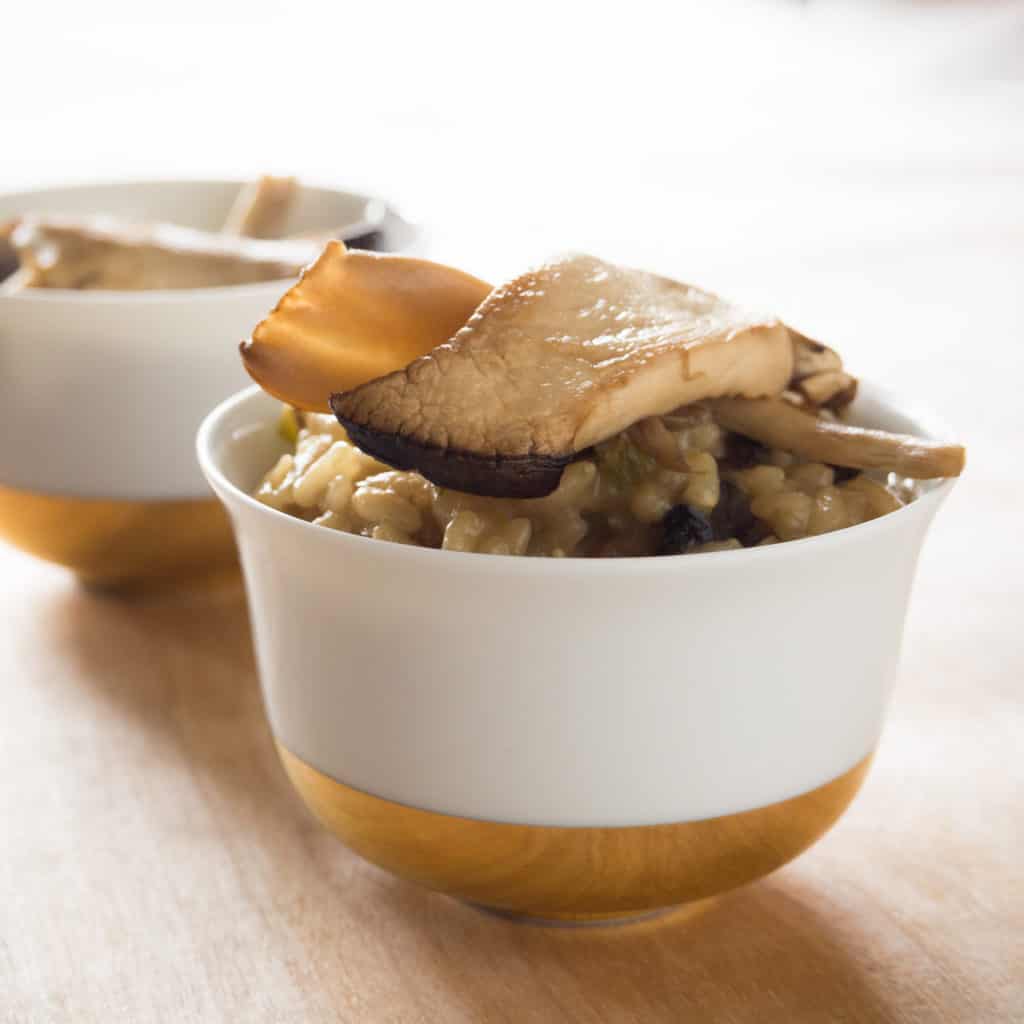
Mushroom Risotto with Grilled Mushrooms and Tarragon is the ultimate comfort food. Tasting of earthy, warm flavours, fresh with the slight aniseed tang of tarragon and with a wonderful silky texture but with a bite. I love this dish. It makes the world alright again. Fresh, seasonal mushrooms can get lost in a risotto. By grilling the mushroom separately and either stirred in at the end – or even served on the side – allows the fresh, nutty flavour and texture of the mushrooms to shine and the risotto to not eat up the delicate mushrooms.
You can find the full Mushroom Risotto with Grilled Mushrooms and Tarragon recipe here.
This risotto is set up wonderfully by the light and delicate Watercress Soup.
You can use any type of fresh mushroom you can get – I used a mixture of shiitake, oyster, girolle and chestnut. If you can forage (be careful!!! And only forage if you know exactly what you are doing or have a guide who does) or buy locally seasonal mushrooms go for those. They will be amazing.
Preparation
Difficulty easy
Preparation time 5 minutes
Cooking time 35 minutes
You can find the full Mushroom Risotto with Grilled Mushrooms and Tarragon recipe here.
Allergens
Mushroom Risotto with Grilled Mushrooms and Tarragon is gluten-free and vegan as well as…
Celery free
Coconut free
Garlic free
Lupin free
Mustard free
Nightshade free
Onion free
Peanut free
Sesame free
Soya free
Tree nut free
About
Risotto is a classic Italian dish originating in northern Italy. Risotto rice is cooked in a broth until becomes creamy. The broth can be meat, fish, or vegetable based. Risotto can contain butter, wine, and onion. In Italy Risotto is normally a primo (first course), served on its own before the main course. Something we are not used to outside of Italy where risotto is served as a main dish!
The rice used for risotto is a high-starch, low-amylose round medium- or short- grain white rice. This type of rice absorbs liquids and releases starch. This results in a creamy, rich dish. The primary varieties of rice used in Italy are arborio, baldo, carnaroli, maratelli, padano, Roma, and vialone nano. Carnaroli, maratelli and vialone nano are considered to be the best, and most expensive, varieties. There are arguments, or discussions, abound about which rice variety is best with personal preference or familiarity dictating choice. The rices all have slightly different properties e.g. carnaroli is less likely than vialone nano to overcook, howver as carnaroli is smaller, it cooks faster and absorbs flavours better. Other varieties like Roma, baldo, ribe and originario may be used but will not have the creaminess of the traditional dish. These varieties are considered better for soups and other non-risotto rice dishes and for making sweet rice desserts. Rice designations of superfino, semifino and fino refer to the size and shape (specifically the length and the narrowness) of the grains, and not the quality.
All risottos follow a similar method where rice is gently fried in oil or butter to ensure each grain is well coated, wine is added and must be absorbed by the grains. When the wine has evaporated, then the heat is raised and very hot stock is added in small amounts, the risotto is stirred gently and constantly. Constant stirring pulls the starch molecules from the rice grains into the surrounding stock. It is this method that develops a smooth, creamy risotto.
‘Properly’ cooked risotto is rich and creamy, but has some resistance or bite (al dente). The traditional texture is fairly fluid. Risotto is often served on flat dishes and should spread on the dish but not look like soup.